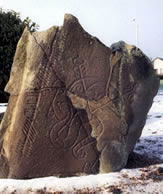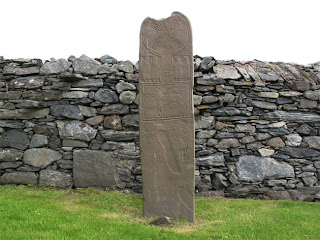Picts
referred to the people who lived in Northern Scotland, in about fourth century
AD. The Picts where mysterious people because they left no written records and
all we know about them is from writers who recorded their own opinion of the
Picts. The Picts where a descendent race from the iron age people of northern
Scotland and where fierce warriors. The Picts art was of a very high quality
and mainly done in stone sculptures and in metalwork. The Picts where highly
influenced by insular styles. Picts stones have three classes into which they
are categorised, class one stones are standing stones, the shape of the stone
is left how it is and on the stone there are carvings of abstract designs,
animals and normal objects. Symbols in the artwork is present for example a
comb and a mirror would symbolize a woman.
These are some class one examples :
This stone is called the Brandsbutt stone which has V-rod, Z-rod and serpent symbols also it has engraved an ogham inscription.
This stone is called the Dunnichen Stone which was discovered in 1811 in Dunnichen hence the name. It is engraved with three symbols which are a double disc and a Z-rod, a mirror and a comb and a Pictish flower which is quite rare.
Class two stones are slabs with crosses carved into the stone, these types of stones combine relief and carvings. The crosses are highly detailed with decoration in the Insular style, some examples of styles found on these crosses are scrollwork, interlace and key-patterns. The stone would have two faces and usually one face had a cross engraved and on the other side decoration of Pictish symbols would be carved, it was not common however stones with both faces with carvings of a cross where also found. The symbols which where scenes from the bible, battle and battles between man and beasts where carved on the back of the stone. These carvings could well be a part of Pictish mythology, here are some class two stone examples :
This stone is called the Aberlemno 3 it is also called the Great Stone. The Celtic cross has two angles carved on each side were one is reading a book also there is a hunting symbol and double disc Pictish symbol.
This stone is called The Aberlemno 2, it has a battle scene on the back face and people believe that it shows the Battle of Nechtansmere in 685 AD and the stone slab is produced about two centuries after the battle. On the stone we can see helmeted soldiers who could be the Anglo Saxons who were defeated in that battle also there is a raven is carved which is eating a dead Anglo Saxon.
Class 3 stones are still done in the Pictish style but done in cross slabs and recumbent stones, class 3 stones lack the characteristic symbols and date after the Scottish took over the Pictish in the middle of the 9th century.
Some examples of class 3 Pictish stones :
This stone sculpture is called The Papil Stone it was found in the south of Papil hence the name. On each side of the cross there are two monks which are holding a croziers and satchels. Further down we see a Prictish lion and near the base you can see two bird men which are done in a different style from the rest of the sculpture. The Pictish lion can date back the stone to 8th Century AD .

This stone sculpture is called The Edderton Stone this sculpture is located in an old graveyard in the village of Edderton hence the name. The stone is made up of red sandstone and has engraved on it on an elegant cross with a circle which means being left in relief. On the stone there are in total 3 riders.
Bibliography.
Papil Pictish Stone Cross Slab Class III Pictish Cross Slab : The Megalithic Portal and Megalith Map:. 2013. Papil Pictish Stone Cross Slab Class III Pictish Cross Slab : The Megalithic Portal and Megalith Map:. [ONLINE] Available at: http://www.megalithic.co.uk/article.php?sid=26810. [Accessed 18 May 2013]
Edderton Cross Slab - Wikipedia, the free encyclopedia. 2013. Edderton Cross Slab - Wikipedia, the free encyclopedia. [ONLINE] Available at:http://en.wikipedia.org/wiki/Edderton_Cross_Slab. [Accessed 18 May 2013].
Pictish, Celtic and Viking stone art from Ancient Images. 2013. Pictish, Celtic and Viking stone art from Ancient Images. [ONLINE] Available at:http://www.ancientstoneart.co.uk/. [Accessed 18 May 2013].
Art in Medieval Scotland - Wikipedia, the free encyclopedia. 2013. Art in Medieval Scotland - Wikipedia, the free encyclopedia. [ONLINE] Available at:http://en.wikipedia.org/wiki/Art_in_Medieval_Scotland. [Accessed 18 May 2013].




.jpg)


















.jpg)





